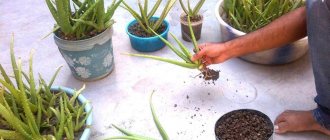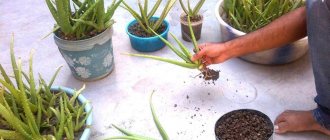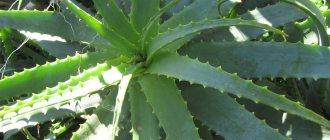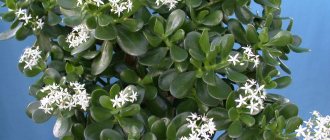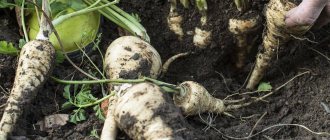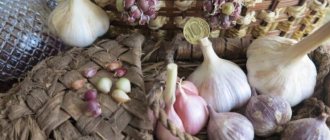Category: Succulents, Care Published 05/04/2018 · Comments: · Reading time: 4 min · Views: 18,677
Many gardeners grow medicinal succulents to obtain medicinal raw materials that help in the treatment of various diseases. How to trim aloe at home to prepare it? Not everyone knows how, because there are certain rules and advice, adhering to which, you will receive the most active products based on aloe juice.
However, pruning aloe is also necessary in some other cases, which cannot be neglected in the process of caring for the plant. It’s worth sorting everything out in order.
Trimming leaves for cuttings
The most common method of plant propagation is cuttings. This method is convenient because aloe can be cut at any time of the year. However, it is recommended to carry out artificial propagation in summer or spring. It is at this time that the growing season for aloe begins.
For this method of propagation it is necessary to use branches from the side of the plant. They are located along the entire length of the stem. They are cut off and placed for a week in a closed room (cabinet, closet) with a humidity of about 45-55%.
On a note! To make a cut, you must use only sharp objects - scissors or a knife. Before this, they must be disinfected and treated.
As a primer, you can choose several mixtures from:
- peat;
- sand;
- ash;
- brick crumbs.
You may be interested in: Caring for buddleia for the winter: how to prune, insulate, features of autumn transplantation. The homeland of lush flowering buddleia is China.
Although this exotic plant has adapted to the harsh Russian...Read more... After all operations, the cutting will be ready for replanting. Substrates are poured into containers and watered generously. A distance of 6 centimeters is maintained between individual processes. When planting, it is recommended to deepen the cuttings into the ground a couple of centimeters. With the appearance of the first roots, aloe needs more frequent and thorough watering.
Please note! Over time, it is recommended to replant the plant as it grows into larger containers. To avoid infection and pests, all containers are pre-disinfected.
How to trim at home?
- Take a sharp knife, scissors or garden pruners.
The choice of tool depends on the size of the plant - compact aloe can be trimmed with a knife, and if the flower has grown to the size of a small tree, use a pruner.
- Remove the leaves located outside, most often they are easy to reach. The cut should be straight and even.
- With one hand, push away the healthy leaves, opening access to the regrowth area of the one being removed.
- Use your other hand to cut off the inner leaves.
- Leaves located inside the plant are removed with the utmost care. The cut should be made very carefully, as close to the stem as possible.
- If there are daughter shoots, remove them - most often they are simply taken out of the pot along with the root. They can be used for reproduction.
- If the “babies” are not removed from the soil, you need to remove the entire plant with roots and cut off the junction of the main flower and the “babies”.
In order to remove aloe from the pot, you need to tilt the pot on its side , holding the plant by the stem and pulling slightly. The flower should come out easily. If this does not happen, you can squeeze the pot a little or lightly tap it on a hard surface.
Flower for medicinal purposes and raw materials
To trim a flower for medicine, it is recommended to use sharp cutting objects. The lower leaves contain a large amount of juice and pulp, so they are best suited for treatment. The leaf must be cut off and cleared of thorns. First, the succulent should be without water for about a week. It is recommended to sprinkle all cuts with charcoal.
Regardless of a person's needs, the leaves must be cut off. Such copies are stored in the refrigerator, in cellophane or a sheet of paper. After a week of storage, the leaf is crushed and the juice is extracted from it. From this juice you can make medicinal tinctures, creams, and face masks. It has been noticed that when the moon is waning or full, the procedure is better tolerated by the plant. To avoid harm to the aloe, it is recommended to perform surgery at this time.
You may be interested in:
DIY succulent arrangement Have you ever been to the subtropics? Well, at least in Crimea or the Caucasus? Please note that...Read more...
Recommendations for pruning aloe
To do this you will need:
- aloe;
- charcoal;
- sand;
- turf land;
- leaf soil;
- black paper.
It is best to cut aloe for cuttings in spring or early summer. Cuttings will be obtained from shoots from eight to fifteen centimeters long. You can use longer branches; before rooting, cut them with a sharp knife into pieces no longer than ten to twelve centimeters.
Dry the cuts by keeping the cuttings for three to four days on a sheet of paper. To avoid rotting of the cuts, sprinkle them with charcoal or crushed activated carbon tablets.
Plant the prepared cuttings in sand moistened with water, burying the stems a centimeter into the substrate. The sand should be kept slightly moist the entire time the cuttings are taking root. The apical cuttings take root well in water. If you prefer this fairly common rooting method, throw an activated carbon tablet into the container in which the aloe shoots stand.
After the shoots have roots, they can be planted in pots filled with a mixture of one part sand, two parts turf and the same amount of leaf soil. It is recommended to add charcoal to aloe soil.
Aloe juice is known for its disinfecting effect and is used to treat burns, inflammation, diseases of the stomach and respiratory system. For medicinal purposes, side shoots and lower leaves of aloe are used, cut in winter or spring from a plant no younger than three years old.
Before cutting off leaves or shoots, it is recommended to keep the plant for two weeks without watering. Cut or break off the leaves from the bottom of the aloe plant as close to the stem as possible and place it in a dark, damp room for five days.
To obtain juice from the plant, cut off the side shoots and, wrapping them in dark paper, keep them for two weeks at a temperature of three to eight degrees. You can put cut aloe in the vegetable drawer of the refrigerator.
Before processing, rinse the prepared shoots and leaves with cool boiled water.
2 parts:
A healthy aloe often exhibits vigorous growth with the formation of new leaves, flowers and even young shoots. For this reason, such plants require regular attention. While aloe requires more delicate pruning than other plants, following some pruning rules will help you protect the plant. By promptly removing damaged parts of aloe and excess shoots, you will ensure healthy growth for your plant and even make it a real decoration of the room.
Planting/growing
Experienced gardeners recommend planting aloe in the spring, at the beginning of the growing season. This time is good for rapid rooting of a young plant. When planting aloe vera, it is very important to pay attention to the soil you will use. It must be loose, not retain water and have good air permeability. Chemical composition: slightly acidic or neutral. The composition should contain a lot of iron. Judging by the description, a mixture of leaf and turf soil, sand and humus is perfect. Compared to the other components of the mixture, there should be twice as much turf soil. To disinfect small stones, you can add charcoal to the soil. By the way, this component will also add a little looseness to the soil. Among the ready-made mixtures, you can buy soil for cacti or succulents. This is a nutritious substrate that will provide all the necessary elements for the active growth of a young plant.
Medicinal properties of aloe
The viscous juice contained in aloe leaves is a real storehouse of vitamins and microelements! It contains vitamins B and E, provitamin A, ascorbic acid (vitamin C), amino acids, phytoncides, polysaccharides, salicylic acid, as well as magnesium, zinc, manganese, selenium, and iron. The list is endless!
On a note! If you are reading this article, you probably own a valuable agave plant? Perhaps you will be interested in an article on caring for a home healer.
The uniqueness of aloe juice is that it can be used both internally and externally. It does not cause allergic reactions and the body easily absorbs it! What problems can the medicinal properties of aloe help you cope with?
- Agave leaf juice has a bactericidal and healing effect. It can be used to disinfect wounds and cuts, treat burns and abrasions. Upon contact with a damaged surface, the healing juice begins to act, killing microbes and accelerating regeneration.
- The plant produces a similar effect on mucous membranes. Therefore, it can often be found in medicinal oral balms, preventative toothpastes, eye drops, and cosmetics for intimate hygiene. It relieves inflammation, irritation, and increases the protective functions of the mucous membrane.
- Aloe juice copes with gastrointestinal problems, helping in the healing of stomach ulcers, improving the enzyme composition of gastric juice, promoting the elimination of toxins. It is often used in the treatment of gastritis, constipation, as well as for rehabilitation after serious illnesses.
- Aloe has antiviral and antimicrobial effects. It is used to prepare rinses and drops against colds and flu. Among other things, the rich composition gives this medicine an immunomodulatory property.
- Being an excellent antiseptic, agave is also able to provide all possible assistance in the treatment of acne and skin rashes. It does not cause allergies, has a drying effect, soothes and relieves redness. Aloe is used mainly for problematic and sensitive skin, as well as in anti-aging cosmetics.
Attention! There are contraindications for internal use, such as pregnancy, a tendency to high blood pressure, kidney and liver disease.
Aloe propagation methods
There are several options for propagating this succulent. We choose a way to propagate aloe at home, for example:
- Radical shoots.
- Plant cuttings.
- Seeds.
- Upper shoots.
Reproduction by root shoots coincides with the planned transplantation of an adult plant. Using a sharp knife, you need to separate the shoot (it is also called “baby”) and place it in a glass of water for the roots to grow. It should take about two to four weeks for the shoot to take root. So, it's time to transplant it into a pot. Then all that remains is to follow the rules on how to grow aloe at home.
Propagation by cuttings involves using a very sharp knife to cut a leaf from an adult plant that has at least eight large leaves. The cut area should dry out a little. Treat the cut with ground activated carbon. This leaf needs to be stored outdoors for about a week. After the cutting site has completely dried, the cuttings can be planted in the ground. If there are a lot of cuttings, then they are planted in rows. Aloe cuttings can be carried out throughout the year.
Propagation by seeds is carried out in early spring, around March-April. You should first prepare small dishes and soil. The room temperature should be more than +20 °C. Water the soil in the container and spread out the seeds, cover it with a thin layer of sand, and cover the container with glass or film. It is necessary to provide watering and spray the emerging leaves in a timely manner. As soon as three true leaves appear, the seedlings need to be transplanted into other containers no more than five centimeters high. After a year, the grown plants are transplanted into larger containers. This is not the easiest method of propagation, but a large number of plants can be grown.
Reproduction by upper shoots occurs in the same way as by basal shoots. After cutting off the top with a sharp knife, the plant is dried for about three days. Then they are planted in wet sand to a depth of three to four centimeters. After rooting, they are transplanted into another container, and then they begin to grow aloe at home like any indoor plant, with love and care.
Root trimming during transplantation
Having taken the plant out of the old pot, free the roots from the ground - shake them off with your hands or wash them in warm water. Carefully inspect the root system; if there are dead or damaged areas, cut them off with a sharp, disinfected instrument - a knife or scissors.
During transplantation, the main root and too long and overgrown lateral roots are shortened. The remaining root ball should occupy 2/3 of the new flower container. All sections must be dried for some time in the fresh air, then the sections must be treated with sulfur or charcoal powder to prevent any infection - fungal, bacterial or viral - from getting into the wounds.
After cutting the roots, the plant is not watered at all for several days to give the cuttings time to heal and the roots to strengthen in the new soil mixture. Usually the succulent tolerates root pruning harmlessly and very soon grows new roots.
If the plant deteriorates
If the owner of the aloe plant notices that after cutting several leaves the plant begins to tilt to one side, it needs to be tied up. If the problem is rotting, it is necessary to remove the entire rotting part .
It is necessary to examine not only the trunk, but also the root system - perhaps the reason is rotting roots. If the plant has become soft, the leaves have changed color, dried out, or pests are noticed, evaluate the general condition of the aloe.
- If several leaves are affected, they need to be cut off.
- Inspect the roots. If rot is detected, carefully cut off the damaged shoots without touching healthy ones.
- When the lower part of the stem is damaged, the plant rots and falls; it can most likely only be saved by replanting (how to replant aloe correctly?). To do this, you need to cut off the top of the aloe, dry the cut for a couple of days at room temperature, then plant it in a small pot for rooting. In this case, it is better to use soil for cacti (what kind of soil is needed for aloe?).
When planting the crown, the trunk does not need to be thrown away for some time - the flower may eventually produce basal shoots , which can also be replanted.
So, pruning aloe is a fairly simple process; the main thing is to sharpen the tool well and select the leaves for cutting in advance. Diseased leaves should be thrown away, healthy leaves (when pruning is done to prevent overgrowth) can be saved for use for medicinal purposes. Constant pruning is not a panacea for yellow leaves and other problems; if a flower dries out or its leaves rot, the problem is in lighting or regularity of watering (how to water aloe correctly?).
If you find an error, please select a piece of text and press Ctrl+Enter.
Many gardeners grow medicinal succulents to obtain medicinal raw materials that help in the treatment of various diseases. How to trim aloe at home to prepare it? Not everyone knows how, because there are certain rules and advice, adhering to which, you will receive the most active products based on aloe juice.
However, pruning aloe is also necessary in some other cases, which cannot be neglected in the process of caring for the plant. It’s worth sorting everything out in order.
Origin
Aloe belongs to the succulent family. In its natural environment, it can be found in the arid regions of southern and eastern Africa. Also, some plant species, of which there are about three hundred in nature, grow in Madagascar, India, and the Arabian Peninsula.
Under natural conditions, aloe grows up to three meters; the lower part of the trunk is covered with the remains of fallen leaves. The main trunk together with the shoots forms a dense shrub. The root system has long, straight roots.
Agave aloe received its name due to the belief that it blooms once every hundred years. But in the natural environment, aloe blooms once or twice a year, throwing out a brush-shaped inflorescence on a long peduncle reaching eighty centimeters. The tubular flowers are four to five centimeters long and one centimeter in diameter. Flowers in shades from white to red are collected in a panicle, elongated in the shape of a spike. A significant amount of nectar collects at the bottom of the bell.
Aloe is unpretentious, surviving in the hot conditions of Africa. Therefore, at home, the plant does not require special attention.
How to store aloe leaves?
The leaves have been cut, but what to do now? In the air, and even at room temperature, such a medicine will not last even a day - the valuable moisture will evaporate and the leaf will dry out. To prevent this from happening, you need to pack it in a bag or cling film and place it on the bottom shelf of the refrigerator, where it is dark, dry and cool.
At a temperature of 4-8 degrees, the sheet can be stored for quite a long time until you decide what to do with it next. There are several options: use fresh raw materials as needed, squeeze out the juice, or prepare a tincture. By the way, there is an opinion that medicinal aloe stored in the refrigerator for 10-12 days only accumulates healing properties. At the same time, the concentration of nutrients in its leaves increases!
Can aloe be stored in the freezer? Of course, the freezer will preserve useful material much longer! And yet, thawed aloe will be similar to thawed fruit: it will become watery and lose some of its beneficial properties.
If you want to use the plant in the preparation of masks, drops, balms, you will have to use a meat grinder or juicer, passing the cut leaves through it. However, fresh medicinal aloe in mushy or liquid form can be stored in the refrigerator for no longer than 2-3 days. Therefore, it is best to preserve such a product!
To prepare an alcohol tincture, mix the juice of the leaves of the plant and alcohol in a 4:1 ratio, or agave juice and vodka in a 2:1 ratio. Place the resulting mixture in a bottle and in the refrigerator for 10 days. This extract can be used instead of fresh aloe juice, it has a similar effect! This preservation method will extend the shelf life of medicinal raw materials by several years. And yet, it is better to store the resulting infusion in the refrigerator!
However, this medicine is often used orally, but not everyone can use alcohol-containing products. Therefore, honey would be a good alternative! This preservative will allow you to preserve the healing juice for a year, provided it is stored in the refrigerator. To prepare a sweet version, mix liquid honey and aloe juice in equal proportions, place in a glass container and refrigerate. After just 4 days you can use the mixture for medicinal purposes!
✿
Why do you need to prune plants?
There are several types of pruning. This:
What to cut off for sanitary purposes?
Sanitation is carried out when the following is removed:
- old dry leaves;
- shoots burned by the sun's rays;
- infected parts of the plant.
Damaged sprouts are still unsuitable for harvesting medicinal raw materials. They spoil the appearance and take a lot of strength from the plant.
Cuttings at home
Aloe is often propagated in such a simple and effective way. The operation can be performed at any time of the year. But experienced flower growers advise doing this in spring or summer.
- Strong, healthy shoots are selected.
- Cut at the very base of the plant.
- The cut roots are slightly dried.
- Then, after treating them with growth stimulants (kornevin), they are planted immediately in a pot of soil.
We offer you to watch a video on how to cut aloe:
Procurement of raw materials
Experts say that aloe reaches its maximum healing properties by the age of five. But many housewives begin to trim their pet after three years. By this time, the succulent grows fleshy, large, juicy shoots. How to cut leaves from aloe?
- Cut off the lowest large leaves near the base. Pruning is done carefully so as not to break the crown or damage the skin.
- Then the collected material is placed in the refrigerator for 10 days. This is necessary so that, under the influence of cold, healing substances begin to be produced in the tissues.
- After the expiration date, the sheets are cut into pieces and dried until completely dry.
- Then you can put them in a canvas bag. You can store it this way for two years.
We offer you to watch a video on how to prepare aloe leaves for cosmetic use:
Removing diseased and damaged roots
Sometimes a plant needs to remove damaged or rot-infected roots.
- The flower is carefully removed from the pot.
- Shake off the soil.
- Trim diseased roots with a sharp knife or scissors.
- Transplant the plant into another pot.
What happens if you don't take care of the plant?
- If there are insects, they will soon infest the entire plant and completely destroy it.
- For the same purpose, they get rid of diseased shoots in order to protect healthy parts.
- It grows quickly and powerful leaves will prevent young shoots from developing properly.
Why is pruning needed?
Those who like to grow aloe at home perform pruning for several purposes.:
- Formation of a beautiful crown. The plant tends to grow quickly, and the lower leaves must be trimmed if transplanting the aloe into a new, more spacious pot is not yet planned.
- Removing old, dying leaves, which take a lot of energy from the plant. Aloe can spend the same energy on growing new, young leaves.
Trimming already dead leaves.
- Protecting the flower from insects. If signs of insect damage have been noticed on the leaves, it is best to remove these leaves immediately before the parasites reach other leaves.
- Collecting leaves for medical purposes. To do this, take the lower leaves, the richest and largest.
If you do not prune aloe if there are insects on it, parasites can eventually settle on all the leaves and completely destroy the plant. For the same purpose, diseased leaves are removed, preventing the spread of the disease.
Failure to trim a healthy flower will lead to rapid overgrowth , and if this overgrowth is not the goal of the aloe owner, the leaves need to be trimmed periodically.
Further care
Aloe does not require special care after cutting leaves. The flower “heals wounds” well, and young leaves will soon appear in place of the cut leaves. You can remove dry petioles yourself - this will speed up the process of growing new leaves and give the aloe an aesthetic appearance.
Many houseplant owners do not even suspect that aloe can bloom. Of course, this happens more often in natural conditions, but you can also achieve this from a flower if you fertilize aloe.
Steps
Part 1 Trimming the visible above-ground part of aloe
- 1 Take a cutting tool.
You will need something that can be used to carefully cut through the aloe leaves, stems and roots, such as a regular kitchen knife. You can also use regular scissors to trim the plant, but if the aloe has already grown large and powerful, you may need garden pruners. - trim aloe 2 Trim damaged leaves.
First of all, pay attention to the unhealthy leaves of the plant. If necessary, carefully pull apart the aloe leaves and stems to get to the plant's dead, drying, or brown leaves. Diseased leaves with severely discolored leaves can also be removed. Trim all of these leaves with a knife or scissors directly at the stem. - Pests and diseases from diseased leaves can move to healthy parts of the plant, so such leaves should be removed.
- The causes of leaf dying may be poor lighting, insufficient or excessive watering.
- trim aloe 3 Trim overgrown leaves.
Using a knife or pruning shears, cut off old leaves that are healthy enough to bring the plant to the size of its container. Bring the cutting tool close to the stem and carefully cut off overgrown leaves. These leaves are the oldest, so they contain the most aloe vera gel. - Aloe vera gel has quite a variety of benefits. If you decide to use cut leaves for medicinal purposes, remove the prickly sides and store them in the refrigerator until the gel is extracted from them.
- Avoid trimming the leaves that are closest to the main stem. These leaves are still young and are needed to replace older leaves.
- trim aloe 4 Remove old stems and flowers.
Trim the aloe stems in the same manner as the leaves. In flowering aloe, the seeds ripen and fall off quite quickly. While the flowers die, they continue to draw nutrients from the plant that could be used to grow new, healthy leaves. But since aloe blooms extremely rarely at home, most likely you will not have to trim the flowers. - Wilted aloe flowers attract insects, often fall directly into the pot, absorb moisture from the soil and generally create a mess.
Part 2 Trimming the ground part of the plant
trim aloe 1 Remove suckers.
Suckers, also called suckers, are the side shoots of the plant.
They draw juices from the main plant and clutter the pot. In most cases, aloe side shoots can be pulled out of the ground without any harm to the main bush. After this, you only need to cut the connecting link between the plant and the baby. Some children may hide in the ground and intertwine their roots with the roots of the main plant. In this situation, you may need to remove the plant from the pot, carefully shake off the soil ball and untangle the roots. Babies are new young aloe vera plants that can be potted into individual pots and grown as well. In addition, these young shoots can then be distributed to friends as gifts. trim aloe 2 Remove the plant from the pot.
Hold the main stem of the aloe and tilt the pot to one side.
The plant should come out of the pot when you pull it a little. If it doesn't budge, try squeezing the pot or tapping it on a hard surface. Next, go after those aloe side shoots that you just couldn't see before. trim aloe 3 Trim the roots.
When transplanting the plant into a new pot, you will need to trim the aloe roots. First, shake off the soil from the roots. Shorten the main long root and trim off some side roots. The amount of pruning should be sufficient so that the remaining roots occupy about 2/3 of the new pot. This will allow the aloe vera to transplant more easily and grow a stronger root system in fresh soil. Water the plant moderately until it fully adapts after transplanting. Pay attention to root rot.
Kinds
Several types of aloe are grown at home.
Aloe arborescens
The most popular type is tree aloe or agave . It is distinguished by an erect stem with long narrow leaves decorated with sharp teeth. At home it can reach a height of one meter. It should be noted that in apartment conditions, agave practically does not bloom, and if you manage to see this rare phenomenon, then its flowers grow small. Due to its medicinal properties it is very popular.
Aloe vera
Aloe vera is distinguished by the absence of a long stem; the fleshy leaves form a dense rosette. The leaves are smoky green with serrated edges and grow up to fifty centimeters. In recent years, aloe vera has become popular due to its use in the cosmetics industry. Under natural conditions, aloe vera grows in the Canary Islands, reaching a height of 80 centimeters.
Aloe Variegata
Aloe Variegata (Variegata) is less common among indoor floriculture enthusiasts. Bright green leaves with white stripes, collected in a rosette, look beautiful. The height of the plant does not exceed forty centimeters.
This may be interesting: Kalanchoe - home care
Sanitary pruning of aloe
Many gardeners doubt whether it is possible to prune aloe. As the plant grows, the lower leaves age, become very discolored, and die. You should not feel sorry for them; it is better to remove them in a timely manner so that they do not serve as a source of spread of fungi and other infections. It is also advisable to cut off damaged leaf plates; they will not develop normally, they will only begin to draw juices and take away the strength of the plant to heal wounds.
You should also promptly cut off side shoots from the mother flower, which are not planned to be used for branching tree-like aloe, as well as root shoots next to the bushy succulent, which are cut off, if possible without shaking the plant out of the pot.
If it is impossible to cut off the root shoot from the mother flower without replanting, cut it off during the replanting process.
Special aloe vera flower
What is unique and useful about the aloe succulent? Caring for a growing plant at home allows you to always have an assistant in the fight against germs, fungi and bacteria.
Aloe vera has an antibacterial and disinfectant effect. You just need to apply the gel to your palms and rub. Germs and dirt will be destroyed by the plant sap.
You can use aloe vera succulent as an effective vegetable and fruit wash, it is a true natural product without chemicals.
Aloe vera flower is rightfully considered a natural analgesic and the first aid for skin damage.
How to prune aloe for cuttings
Aloe usually grows compactly, but tree-like ones often lose their lower leaves as they die. What remains is a trunk with a small tuft at the top, completely devoid of decorativeness. Such a plant can be rejuvenated by cutting off the top separately; the remaining trunk is also cut off, leaving a small stump, which continues to be cared for in the same way as an adult specimen. Soon, side buds appear on the side of the stump, producing young shoots, and the result is a new plant with a uniform decorative crown.
The top is dried for several hours and rooted in a damp peat-sand mixture, and the stem can also be adapted for propagation by cutting it into fragments with several internodes. The pieces are also left for several hours so that the cuts dry, then they are dusted with charcoal powder and proceed in the same way as with the top.
If you do not plan to disassemble the succulent for “spare parts”, but simply want to cut off a shoot in order to plant a new small plant, then they try to do this at the beginning of the growing season, although aloe takes root well at any time of the year. A side shoot is cut off with a disinfected sharp instrument, and the place where it grew is sprinkled with charcoal. It is not recommended to break off the shoot - the torn edges of the wound heal worse than a neat cut.
